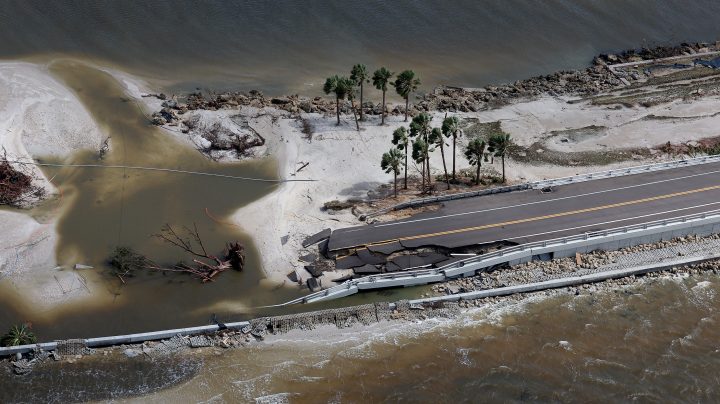
How do we make roads and bridges more resilient?

As Hurricane Ian works its way up the East Coast, the state of Florida is assessing the damage the storm inflicted on its roads and bridges. At least two major bridges appear to have been destroyed, including the Sanibel Causeway, which means thousands of people on Sanibel Island are cut off from the mainland. Many roads are closed, and a team of 100 engineers is inspecting other bridges.
The price tag to rebuild all this infrastructure will be high, and with a changing climate, it can be hard to prepare for a tomorrow that’s a lot different from yesterday.
There are things we can do to make roads and bridges more resilient to storms: Build them higher off the ground, put them in places that are less likely to flood and add features that absorb or divert water.
“So that can be things like permeable pavement. It can be things like culverts, drainage ditches,” said Melissa Roberts with the American Flood Coalition.
But the federal government doesn’t provide any incentive to do things differently in rebuilding after a disaster.
“It defaults to building things back exactly the same way they were before,” Roberts said.
And the problem is, the before times aren’t likely to come back.
Maria Lehman is the incoming president of the American Society of Civil Engineers. She’s worked on bridges herself and is with the engineering firm GHD.
“Some of the stuff that Florida saw, I mean they saw a foot of water in 24 hours,” Lehman said. “Nothing’s been designed for that.”
Lehman said designing and building stronger structures can cost more, but it’s still cheaper than rebuilding after the next hurricane hits.
“You’re going to pay me now or you’re going to pay me later,” she said.
Another challenge is that people don’t always want the changes that come with resilient infrastructure. Sometimes higher roads accommodate less traffic, for instance.
“Hearing the roads being narrowed or or less lanes makes folks nervous about being able to have their business operations function the way they always have,” said Kyle Spencer, the chief resilience officer for the port city of Norfolk, Virginia.
In the near term, Norfolk’s experimenting with installing sensors in its roads so it can let residents know when one is flooded.
There’s a lot happening in the world. Through it all, Marketplace is here for you.
You rely on Marketplace to break down the world’s events and tell you how it affects you in a fact-based, approachable way. We rely on your financial support to keep making that possible.
Your donation today powers the independent journalism that you rely on. For just $5/month, you can help sustain Marketplace so we can keep reporting on the things that matter to you.

















